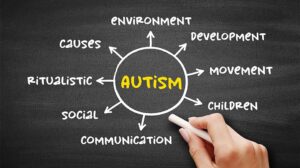Autism Spectrum Disorder (ASD) affects millions of children worldwide, presenting unique challenges that can impact their communication, social skills, sensory processing, and overall functioning. ABA Therapy is a research-based approach to help children with Autism develop new skills and tackle challenges, helping them unlock their full potential and live happy, meaningful lives.
If you are a parent or caregiver of a child with Autism, you may be overwhelmed by the path forward and the options presented to you, ABA Therapy being one of them. In this article, we’ll discuss what ABA Therapy is, how it works, and its outcomes.
What is ABA Therapy?
Applied Behavior Analysis (ABA) Therapy is a structured and evidence-based approach used to support children with Autism.
ABA Therapy starts with understanding a child’s strengths, challenges, and specific needs. Based on an initial assessment, individualized treatment plans are created. The therapy sessions consist of breaking down skills or behaviors into smaller, manageable steps and using positive reinforcement to encourage desired behaviors. These steps are repeated and gradually shaped to build new skills.
ABA Therapy also addresses challenging behaviors by identifying the underlying causes and implementing strategies to reduce them. It emphasizes functional communication, social skills, daily living skills, and independence.
How does ABA Therapy work?
As parents begin researching ABA as a possibility for their child with Autism, they may find vastly different approaches between different providers. Not all ABA Therapy is the same, and the ABA Therapy of the past looked very different than the modern approaches used today.
Most providers utilize what’s called the “ABCs”, which is an ABA principle for understanding (and then modifying) behavior.
ABC stands for:
- Antecedent – what happened before the behavior occurred
- Behavior – what behavior the child exhibited
- Postcedent – what happened after the behavior
Looking at what happened right before, during, and after a behavior can help us understand the underlying reason for a child’s behavior, and how to respond accordingly in the future. The ABCs are only a part of the full ABA picture.
At Westside, we use a methodology called “Today’s ABA”, which utilizes the most modern and research-based techniques. It was created by Dr. Greg Hanley, a well-respected thought leader in the field of Autism. Using “Today’s ABA” principles, we follow a Skill-Based Treatment Model and ABA philosophy centered around LISTENING to the child, and learning through an environment of joy, empowerment, and respect.
Skill-Based Treatment Model
Every child with Autism is different and presents unique strengths and challenges. This is why it’s called a spectrum disorder. Some children with Autism engage in problematic behavior that is very intense and concerning, both for the child and their caregivers. With the proper support, children can learn the communication and tolerance skills necessary to live free from problematic behavior.
Westside uses a Skill-Based Treatment Model that begins with communication and then progressively moves up through various higher-level skills.
Functional communication is always the starting point, and this refers to a child communicating in order to get their needs met. Communication can be in the form of speech, gesturing, or adaptive communication devices. The goal is for the child to express to a caregiver what they need or want – for example, a cup, milk, snack, swing, etc. When a child can communicate their basic needs, they feel less anxiety and are less likely to engage in problematic behavior. Additionally, communication increases confidence!
After communication, we work on toleration, which is accepting that sometimes the answer is “no”. Children with Autism often struggle with understanding “no”, but this is a crucial safety skill. Understanding “no” and “stop” reduces dangerous behavior and elopement issues, like running into the street.
Next, we slowly relinquish our reinforcers. ABA is built upon frequent positive reinforcement. During this phase, we gradually reduce our reliance on reinforcers while ensuring that the child continues to engage in the required tasks.
Finally, we work on transitioning to a workspace or table, where we can work on more complex and challenging tasks. This is a transitional phase that prepares children for the school environment and beyond.
In addition to eliminating problematic behaviors, the goal is always to graduate a child to the least-restrictive school environment, where they have the foundational skills necessary to thrive both academically and socially.
Westside’s ABA Philosophy
Following the “Today’s ABA” methodology, Westside believes in listening to the child, building an environment of trust, and learning through fun and engaging activities. Our specific ABA philosophy is outlined below.
Fun & Engaging Interactions
Learning should be fun. As therapists, we prioritize creating a positive and engaging environment for your child. We want them to be excited about being at Westside! We always follow their lead and respect their choices, and the child/therapist relationship is prioritized above everything else.
Positive & Empowering Relationships
We use empathy to empower kids, always fostering trust instead of enforcing compliance. We honor their communication efforts and prioritize trauma-informed care. Our ABA teaches kids that they have control, and they don’t need to comply with anything unwillingly. With empathy as our guide, we provide unwavering support.
Child-Centered Approach
At Westside ABA, we believe in personalized programs for each child. We prioritize the holistic development of your child, addressing their unique needs and interests. We listen to families and adapt our treatment accordingly. Our approach is flexible, and we seek research, consultations, and feedback for guidance.
Importance of Natural Environment
We believe in teaching in the natural environment. This means that we go beyond discrete trials and table time, and teach in a variety of different settings and styles. This better enables children to carry over their skills into their home, school, and community when they are outside of ABA.
Focus on Age-Appropriate Social Interaction
We have three different ABA programs where children are grouped together based on age and skill level. In these groups – IGNITE, RISE, and FOCUS, we use the principles of ABA to help children with school and social skills. You can learn more about our therapeutic group programs here.
What Are the Outcomes of ABA Therapy?
ABA is recognized as an evidence-based and highly effective treatment endorsed by the US Surgeon General and the American Psychological Association. It has undergone rigorous scientific testing.
Over 20 studies have demonstrated that intensive and long-term ABA therapy produces significant improvements in outcomes for many children with Autism. “Intensive” refers to programs that provide 25 to 40 hours of therapy per week, while “long-term” indicates a duration of 1 to 3 years. These studies have shown enhancements in intellectual functioning, language development, daily living skills, and social functioning.
It’s important to note that ABA outcomes will vary based on the age of the child, number of hours provided, duration of therapy, and the child’s specific challenges. However, parent communication is key to ABA at Westside. We are constantly tracking progress toward goals and providing parents with these updates. There should never be a question as to how your child is progressing in ABA Therapy.
If you are interested in learning more about ABA Therapy at Westside, please click the link below or call us at (815) 469-1500 and our team will walk you through the process.







